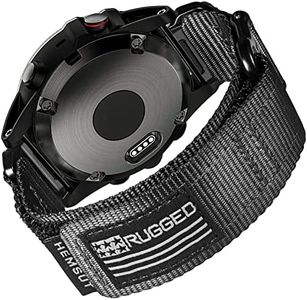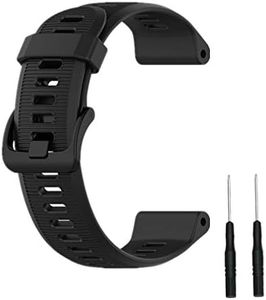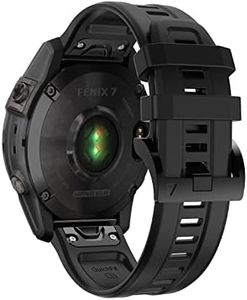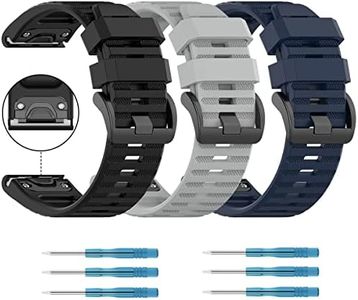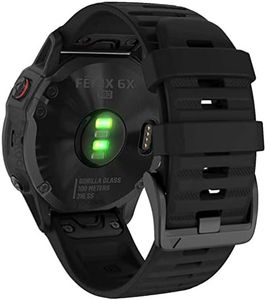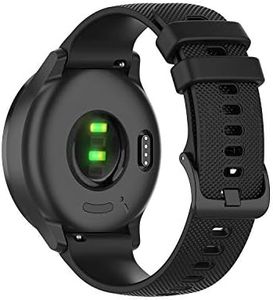We Use CookiesWe use cookies to enhance the security, performance,
functionality and for analytical and promotional activities. By continuing to browse this site you
are agreeing to our privacy policy
7 Best Garmin Watch Bands
From leading brands and best sellers available on the web.By clicking on a link to a third party's website, log data is shared with that third party.
Buying Guide for the Best Garmin Watch Bands
Choosing the right watch band for your Garmin watch can make a big difference in comfort, style, and functionality. Whether you're upgrading for fashion, needing something sportier for workouts, or just replacing an old strap, it's important to know how to select a band that fits both your watch and your lifestyle. You'll want to match the band with how you use your watch, whether it's daily wear, sports, or even swimming. Take a moment to consider how and when you use your Garmin watch most, as this will help guide the right choice for you.Band MaterialBand material is what the watch strap is made of and it greatly affects comfort, durability, and suitability for activities. Common materials include silicone, leather, nylon, metal, and fabric. Silicone and nylon bands are best for sports and swimming since they're lightweight and water-resistant, while leather and metal can look more stylish for everyday or formal use but may not handle sweat or water as well. If you use your Garmin mainly for workouts or outdoor adventures, prioritize silicone or nylon. If you want something for office or casual wear, leather or metal might feel and look better.
Band WidthBand width refers to the size of the end of the strap that attaches to the watch. It's usually measured in millimeters and must match the width of your Garmin watch's lugs (the part where the strap connects). Wider bands typically look sportier and more robust, while narrower bands may feel more subtle or delicate. Always check your watch’s original band width before buying a replacement to ensure a secure fit. If you want a band that feels secure and balanced on your wrist, match the width exactly—don't choose a much narrower or wider band for your specific watch model.
Band LengthBand length determines how well the watch fits your wrist. It’s usually marked as standard, long, or extra-long, and measured in millimeters or inches. If your wrist is smaller, opt for shorter lengths to avoid excess band sticking out; those with larger wrists should look for longer bands for a comfortable fit. Comfort and security are the goals here, so try to match the band length to your wrist measurement or the existing band that fits you well.
Closure TypeThe closure is how you fasten the band, with options like buckle, clasp, Velcro, or quick-release. Buckle closures are common and adjustable, working well for most users. Clasps may give a dressier look and are convenient for metal bands. Velcro is the easiest for fast adjustments, great for sports or when you need to take the watch off and on quickly. Consider which closure feels most secure and is easiest for you to use in your daily routine.
CompatibilityCompatibility means ensuring the band will properly fit and work with your specific Garmin watch model. Not all Garmin bands fit all watches, so always check if the band is specifically designed for your watch or has universal fittings that match. Some models use special connectors while others work with standard spring bars. Confirm the band fits your watch’s attachment mechanism—otherwise, you may end up with a band that doesn’t attach securely.
Water ResistanceWater resistance describes how well the band holds up against sweat, rain, swimming, or other contact with moisture. Silicone and nylon bands are generally very water-friendly, while leather and some fabric bands may absorb water and wear out faster. If you swim with your watch or use it in damp conditions, pick a band specifically labeled as water-resistant or waterproof for long-term durability.
Style and ColorStyle and color let you personalize your band to match your look or activity. Garmin bands come in many colors and designs—some are sporty, others more classic or elegant. If you want your watch to serve at both the gym and the office, consider a neutral color or an easy-switching system, so you can change bands quickly. Choose a style and color that matches your wardrobe and personal taste, and think about whether you want a statement accessory or a subtle look.
